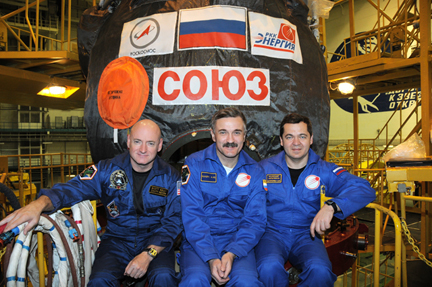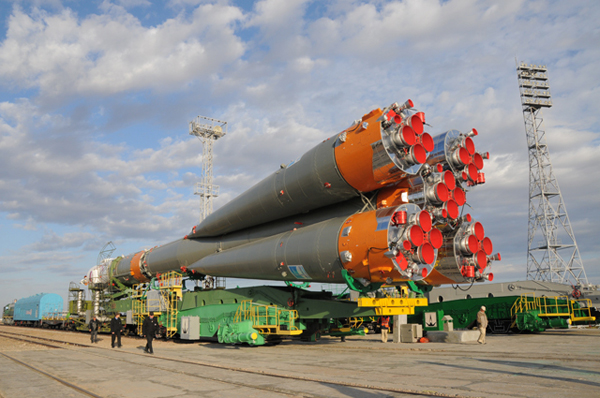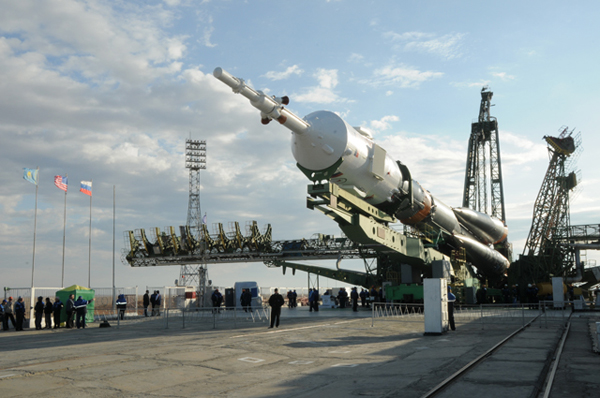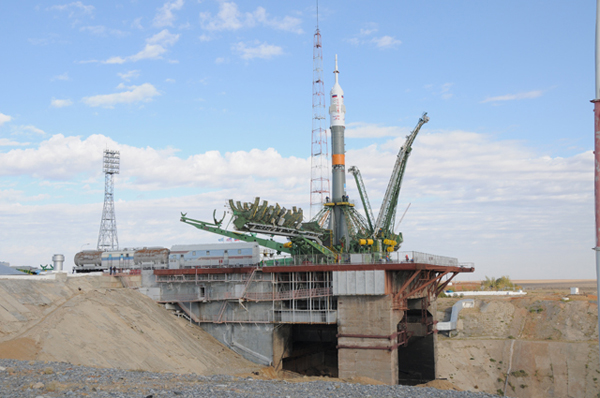Soyuz TMA-01M spacecraft moved to launch pad (UPDATED)
Editor's note...
Veteran shuttle commander Scott Kelly, Alexander Kaleri and Oleg Skripochka are preparing for blastoff to the International Space Station Thursday evening (U.S. time) from the Baikonur Cosmodrome in Kazakhstan. Liftoff aboard the upgraded Soyuz TMA-01M spacecraft is targeted for 7:10:55 p.m. EDT (23:10:55 GMT) Thursday.
The Soyuz rocket was rolled to the launch pad Tuesday. All three crew members will participate in a traditional pre-launch news conference that will be replayed on NASA television Wednesday.
"It's a pretty reliable system," Kelly said of the venerable Russian rocket. "The Russians have been flying it since the 1960s, I think my flight will be the 107th flight of the Soyuz system. We're really fortunate to have this partnership where we can change launch vehicles and not have our own access to space while we still utilize our space station."
Assuming an on-time liftoff, the Soyuz TMA-01M spacecraft will dock at the upward-facing Poisk compartment atop the space station's Russian Zvezda command module around 8:02 p.m. Saturday (00:02 GMT Sunday). A countdown and launch-to-docking timeline is posted below.
Kelly, Kaleri and Skripochka will join Expedition 25 commander Douglas Wheelock, Shannon Walker and Fyodor Yurchikhin, who have had the station to themselves since the departure of three other crew members Sept. 25. In turn, Wheelock, Walker and Yurchikhin are scheduled to return to Earth Nov. 30. With Wheelock's departure, Kelly will take over as commander of Expedition 26 with three fresh crew members scheduled to arrive in mid December.
"When we first started training for this, I thought it was going to be sort of like a lot of the ISS missions we've had where you had potentially long periods of time between visiting vehicles," Kelly said. "But as our flight turns out, it's starting to look much more like a five-month shuttle mission than a long-duration mission."
Kelly's crew will oversee two space shuttle visits, one in November and the other in February, a Soyuz departure and arrival and dockings by four unmanned cargo ships launched by Russia, Japan and the European Space Agency. In addition, three Russian spacewalks are planned.
"We're finishing up assembly of the space station and it's really time to start ramping up the science we're going to do on board," Kelly said. "We hope to average about 30 hours a week of crew time for dedicated ISS science."
Here is an updated timeline of launch-through-docking activities (in EDT and mission elapsed time):
- Updated at 12:25 PM, 10/06: Posting updated launch-to-docking timeline.
 |
Expedition 25 crew members Scott Kelly, left, Alexander Kaleri, center, and Oleg Skripochka. (Photo: RSC Energia) |
The Soyuz rocket was rolled to the launch pad Tuesday. All three crew members will participate in a traditional pre-launch news conference that will be replayed on NASA television Wednesday.
"It's a pretty reliable system," Kelly said of the venerable Russian rocket. "The Russians have been flying it since the 1960s, I think my flight will be the 107th flight of the Soyuz system. We're really fortunate to have this partnership where we can change launch vehicles and not have our own access to space while we still utilize our space station."
Assuming an on-time liftoff, the Soyuz TMA-01M spacecraft will dock at the upward-facing Poisk compartment atop the space station's Russian Zvezda command module around 8:02 p.m. Saturday (00:02 GMT Sunday). A countdown and launch-to-docking timeline is posted below.
Kelly, Kaleri and Skripochka will join Expedition 25 commander Douglas Wheelock, Shannon Walker and Fyodor Yurchikhin, who have had the station to themselves since the departure of three other crew members Sept. 25. In turn, Wheelock, Walker and Yurchikhin are scheduled to return to Earth Nov. 30. With Wheelock's departure, Kelly will take over as commander of Expedition 26 with three fresh crew members scheduled to arrive in mid December.
"When we first started training for this, I thought it was going to be sort of like a lot of the ISS missions we've had where you had potentially long periods of time between visiting vehicles," Kelly said. "But as our flight turns out, it's starting to look much more like a five-month shuttle mission than a long-duration mission."
Kelly's crew will oversee two space shuttle visits, one in November and the other in February, a Soyuz departure and arrival and dockings by four unmanned cargo ships launched by Russia, Japan and the European Space Agency. In addition, three Russian spacewalks are planned.
"We're finishing up assembly of the space station and it's really time to start ramping up the science we're going to do on board," Kelly said. "We hope to average about 30 hours a week of crew time for dedicated ISS science."
 |
The Soyuz TMA-01M launcher is hauled to the launch pad at the Baikonur Cosmodrome. (Photo: NASA/Rob Navias) |
 |
The rocket reaches the launch pad. (Photo: RSC Energia) |
 |
The rocket is elevated vertical. (Photo: RSC Energia) |
 |
The Soyuz TMA-01M spacecraft mounted on the pad. (Photo: RSC Energia) |
Here is an updated timeline of launch-through-docking activities (in EDT and mission elapsed time):
DD...HH...MM...SS...EDT...........EVENT
10/07/10
00...06...00...00...01:10 PM......Batteries installed in booster
00...05...30...00...01:40 PM......State commission 'go'
00...05...15...00...01:55 PM......Crew arrives at site 254
00...05...00...00...02:10 PM......Tanking begins
00...04...20...00...02:50 PM......Spacesuit donning
00...04...00...00...03:10 PM......Booster is loaded with liquid oxygen
00...03...40...00...03:30 PM......Crew meets delegations
00...03...10...00...04:00 PM......Reports to the state commission
00...03...05...00...04:05 PM......Transfer to launch pad
00...03...00...00...04:10 PM......1st/2nd stage oxygen fueling complete
00...02...35...00...04:35 PM......Crew arrives at launch vehicle
00...02...30...00...04:40 PM......Crew ingress
00...02...00...00...05:10 PM......Crew in re-entry vehicle
00...01...45...00...05:25 PM......Re-entry vehicle hardware tested
00...01...30...00...05:40 PM......Hatch sealed and tested
00...01...00...00...06:10 PM......Launch vehicle control system preps
00...01...00...00...06:10 PM......Gyro activation
00...00...45...00...06:25 PM......Launch pad service structure halves lowered
00...00...40...00...06:30 PM......Suit leak checks
00...00...40...00...06:30 PM......Re-entry vehicle testing complete
00...00...30...00...06:40 PM......Emergency escape system armed
00...00...25...00...06:45 PM......Service towers retracted
00...00...15...00...06:55 PM......Suit leak checks complete; escape system to auto
00...00...10...00...07:00 PM......Gyros uncaged; on-board recorders activated
00...00...07...00...07:03 PM......Prelaunch operations complete
00...00...06...15...07:04 PM......Final launch countdown operations to auto
00...00...06...00...07:04 PM......Launch complex and vehicle systems ready
00...00...05...00...07:05 PM......CDR's controls activated
00...00...05...00...07:05 PM......Launch key inserted
00...00...03...15...07:07:40 PM...Combustion chamber nitrogen purge
00...00...02...30...07:08:25 PM...Booster propellant tank pressurization begins
00...00...02...15...07:08:40 PM...Ground propellant feed terminated
00...00...01...00...07:09:55 PM...Vehicle to internal; 1st umbilical tower sep
00...00...01...00...07:09:55 PM...Auto sequence start
00...00...00...40...07:10:15 PM...Ground power umbilical to 3rd stage separates
00...00...00...20...07:10:35 PM...Launch command given
00...00...00...20...07:10:35 PM...Central/side pod engines on
00...00...00...15...07:10:40 PM...Second umbilical tower separates
00...00...00...10...07:10:45 PM...Engine turbopumps at flight speed
00...00...00...05...07:10:50 PM...Engines at maximum thrust
00...00...00...00...07:10:55 PM...LAUNCH
00...00...08...45...07:19:40 PM...Orbital Insertion
00...03...40...12...10:51:07 PM...DV-1 rendezvous burn (20.8 mph)
10/07/10
00...04...09...01...11:19:56 PM...DV-2 (52 mph)
10/08/10
01...00...37...30...07:48:25 PM...DV-3 (4.5 mph)
01...21...57...05...05:08:00 PM...US to Russian attitude control handover
01...22...09...05...05:20:00 PM...ISS maneuvers to docking attitude
01...22...31...54...05:42:49 PM...AR&D Automated Rendezvous start
01...22...48...28...05:59:23 PM...AR&D DV-4/impulse 1 (49 mph)
01...23...10...15...06:21:10 PM...AR&D impulse 2 (3.1 mph)
01...23...13...05...06:24:00 PM...Soyuz Kurs-A Activation
01...23...15...05...06:26:00 PM...SM Kurs-P Activation
01...23...33...34...06:44:29 PM...Range = 62 miles: Soyuz VHF-2 voice link
01...23...35...30...06:46:25 PM...AR&D DV-5/impulse 3 (36.8 mph)
01...23...38...34...06:49:29 PM...Range = 49.7 miles: Valid Kurs-P range data
01...23...51...21...07:02:16 PM...Daily orbit 1 Russian ground station AOS
01...23...59...34...07:10:29 PM...Range = 9.3 miles: Kurs-A & Kurs-P short test
01...23...59...48...07:10:43 PM...Sunrise
02...00...06...34...07:17:29 PM...Range = 4.9 miles: Soyuz TV activation
02...00...14...24...07:25:19 PM...Daily orbit 1 Russian ground station LOS
02...00...14...57...07:25:52 PM...AR&D impulse 4 (14.2 mph)
02...00...16...54...07:27:49 PM...AR&D ballistic targeting point
02...00...19...40...07:30:35 PM...AR&D impulse 5 (13.5 mph)
02...00...22...24...07:33:19 PM...AR&D impulse 6 (4 mph)
02...00...25...22...07:36:17 PM...AR&D flyaround mode start
02...00...34...25...07:45:20 PM...AR&D stationkeeping start
02...00...40...05...07:51:00 PM...AR&D final approach start
02...00...43...05...07:54:00 PM...ISS inertial snap-and-hold window open
02...00...51...05...08:02:00 PM...DOCKING (Poisk zenith)
02...00...53...05...08:04:00 PM...ISS inertial snap-and-hold window close
02...00...55...27...08:06:22 PM...Sunset
02...01...13...05...08:24:00 PM...Soyuz hooks closed
02...01...24...40...08:35:35 PM...Daily orbit 2 Russian ground station AOS
02...01...47...26...08:58:21 PM...Daily orbit 2 Russian ground station LOS
02...02...14...05...09:25:00 PM...Russia to US attitude control Handover